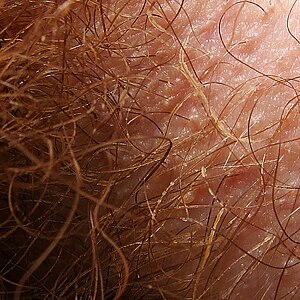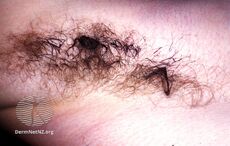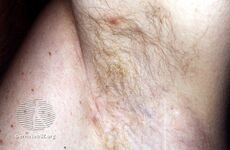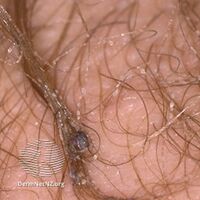Trichobacteriosis axillaris
| Trichomycosis axillaris | |
|---|---|
 | |
| An armpit with variably encrusted hairs | |
| Specialty | Dermatology |
| Prevention | Good personal hygiene, deodorants containing aluminum chloride, topical benzoyl peroxide[1] |
Trichobacteriosis axillaris is a superficial bacterial colonization of the hair shafts in sweat gland–bearing areas, such as the armpits and groin.[2] It typically presents with yellow, black or red grainy bumps on hair shafts, generally associated with a bad smell.[1] Hair may appear beaded or thick and sweat may look yellow, red or black, and typically stains clothing.[1] It may occur in association with erythrasma and pitted keratolysis.[3]
The condition is generally caused by an overgrowth of Corynebacteria.[1] Risk factors include warm humid climates, over crowding living conditions, poor hygiene, excessive sweating, and obesity.[1] It does not spread from person to person.[2] Nits may appear similar.[2] Treatment involves shaving the hair, controlling sweating, better personal hygiene and applying antiseptics.[2] Applying clindamycin, erythromycin or fusidic acid may be effective.[1] Clotrimazole powder is an alternative.[1] Prevention of recurrences can be helped by using deodorants containing aluminum chloride solution, and using antiseptics such as benzoyl peroxide.[1]
Signs and symptoms
Trichobacteriosis axillaris is characterized by the presence of concretions along the hair shafts, clinically observed as yellow, and rarely as red or black nodules. These concretions derive from bacterial colonization along the hair shaft containing dried apocrine sweat with a cementing substance generated by the bacteria.[4]
-
Trichobacteriosis axillaris
-
Trichobacteriosis axillaris
-
Trichobacteriosis axillaris
Cause
The condition is generally caused by an overgrowth of Corynebacteria.[1] Obesity, hyperhidrosis, poor local hygiene, and warm, moist environments are common predisposing factors.[1]
Diagnosis
The infection is diagnosed by close examination of the hair shafts where brown to yellow material called concretions are seen. There is usually an associated rancid odour. A microscopic examination can confirm the diagnosis, but this is rarely needed.[5]
It may occur in association with erythrasma and pitted keratolysis; the corynebacterial triad.[3]
Treatment
Treatment includes shaving of the affected area for a period of 2–3 weeks.[5][6] The use of a concomitant treatment, such as sulfur soaps or benzoyl peroxide[7] is also recommended.[4] Rubbing whilst washing may help to disrupt the biofilm, hence increasing the accessibility of antiseptics to the bacteria.[8]
History
The condition has been called extensively trichomycosis axillaris in the literature, but because it is a bacterial infection and not a fungal infection, it should be called trichobacteriosis.[4]
See also
References
- ↑ 1.0 1.1 1.2 1.3 1.4 1.5 1.6 1.7 1.8 1.9 Gomez, Jannet (April 2016). "Trichomycosis axillaris". dermnetnz.org. Archived from the original on 18 May 2023. Retrieved 2 June 2023.
- ↑ 2.0 2.1 2.2 2.3 Wollina, Uwe (2020). "44. Yellowish axillary hair". In Lotti, Torello; Tirant, Michael; Parsad, Davinder (eds.). Clinical Cases in Pigmentary Disorders. Switzerland: Springer. p. 203. ISBN 978-3-030-50823-4. Archived from the original on 2023-07-02. Retrieved 2023-06-02.
- ↑ 3.0 3.1 James, William D.; Elston, Dirk; Treat, James R.; Rosenbach, Misha A.; Neuhaus, Isaac (2020). "14. Bacterial infections". Andrews' Diseases of the Skin: Clinical Dermatology (13th ed.). Edinburgh: Elsevier. p. 266. ISBN 978-0-323-54753-6. Archived from the original on 2023-07-01. Retrieved 2023-06-02.
- ↑ 4.0 4.1 4.2 Bonifaz A, Váquez-González D, Fierro L, Araiza J, Ponce RM (January 2013). "Trichomycosis (trichobacteriosis): clinical and microbiological experience with 56 cases". International Journal of Trichology. 5 (1): 12–6. doi:10.4103/0974-7753.114704. PMC 3746219. PMID 23960390.
- ↑ 5.0 5.1 Huang C, Liaw F, Liu Y, Wang W (2013). "Answer: Can you identify this condition?". Canadian Family Physician. 59 (6): 648. PMC 3681455.
- ↑ Barboza-Guadagnini L, Fernández-Figueras MT, Bassas-Vila J (September 2015). "Creamy Yellow Concretions in Axillary Hair". JAMA Dermatology. 151 (9): 1023–4. doi:10.1001/jamadermatol.2015.0989. PMID 25970422.
- ↑ Swart MN, Weinberg AN. Bacterial diseases with cutaneous involvement. In: Fitzpatrick’s Dermatology in General Medicine, 6th edn. New York: McGraw-Hill, 2003: 1843–1878.
- ↑ Blaise G, Nikkels AF, Hermanns-Lê T, Nikkels-Tassoudji N, Piérard GE (September 2008). "Corynebacterium-associated skin infections". International Journal of Dermatology. 47 (9): 884–90. doi:10.1111/j.1365-4632.2008.03773.x. PMID 18937649.
External links
| Classification | |
|---|---|
| External resources |


